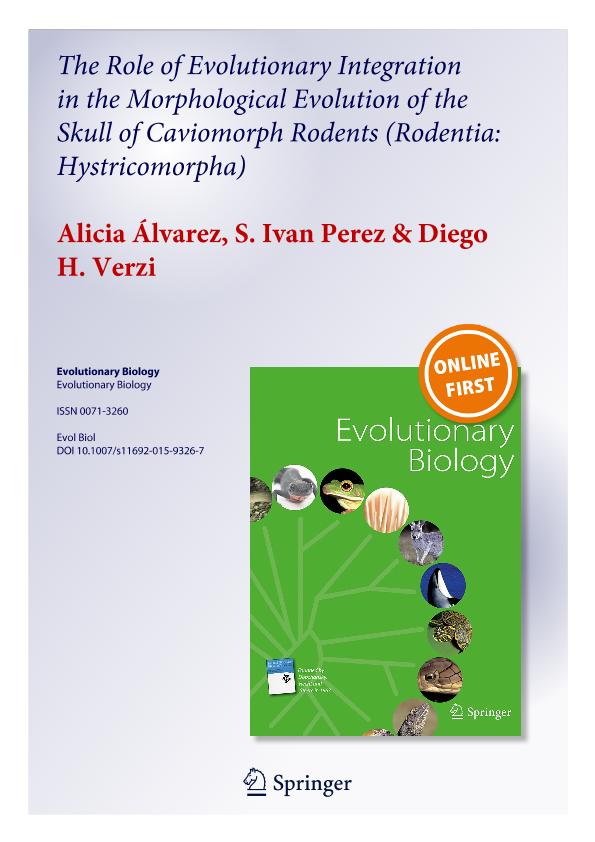Mostrar el registro sencillo del ítem
dc.contributor.author
Alvarez, Alicia

dc.contributor.author
Perez, Sergio Ivan

dc.contributor.author
Verzi, Diego Hector

dc.date.available
2018-05-23T18:08:36Z
dc.date.issued
2015-05
dc.identifier.citation
Alvarez, Alicia; Perez, Sergio Ivan; Verzi, Diego Hector; The role of evolutionary integration in the morphological evolution of the skull of caviomorph rodents (Rodentia: Hystricomorpha); Springer; Evolutionary Biology; 42; 5-2015; 312-327
dc.identifier.issn
0071-3260
dc.identifier.uri
http://hdl.handle.net/11336/46003
dc.description.abstract
The mammalian cranium is a complex structure composed by three partially independent modules: face, cranial base and cranial vault. At the same time, it interacts with the mandible by sharing the masticatory function. Since these units develop and work together, their function and evolution may occur through correlated changes. Here, we assessed the patterns of evolutionary shape variation and covariation (i.e. integration) of cranial modules and mandible among the highly ecomorphologically diverse caviomorph rodents, and the potential evolutionary consequences on the morphological evolution of this clade. Threedimensional geometric morphometrics was used to describe cranio-mandibular shape. The phylogenetic signal and evolutionary allometric component of morphometric variables were analyzed; in addition, evolutionary covariation among cranial modules and mandible was assessed using phylogenetic comparative methods. Significant phylogenetic signal and evolutionary allometry were detected. Large covariance values, involving coordinated breadth increase as the main shape change, were recorded between cranial vault and base, followed by cranial vault and face, and face and mandible. Since the basicraniummay be the main cranial integrator, the overall widening of the cranial base, derived from the enlargement of the auditory bullae, could be influencing the integrated evolution of skull. In caviomorphs, the craniomandibular morphological evolution would be the outcome of a tight covariation among the modular units, and this could be driven by several factors such as allometry and specializations<br />to environmental niches.
dc.format
application/pdf
dc.language.iso
eng
dc.publisher
Springer

dc.rights
info:eu-repo/semantics/openAccess
dc.rights.uri
https://creativecommons.org/licenses/by-nc-sa/2.5/ar/
dc.subject
Caviomorph Rodents
dc.subject
Evolutionary Allometry
dc.subject
Geometric Morphometrics
dc.subject
Morphological Integration
dc.subject.classification
Otras Ciencias Biológicas

dc.subject.classification
Ciencias Biológicas

dc.subject.classification
CIENCIAS NATURALES Y EXACTAS

dc.title
The role of evolutionary integration in the morphological evolution of the skull of caviomorph rodents (Rodentia: Hystricomorpha)
dc.type
info:eu-repo/semantics/article
dc.type
info:ar-repo/semantics/artículo
dc.type
info:eu-repo/semantics/publishedVersion
dc.date.updated
2018-05-23T16:30:50Z
dc.journal.volume
42
dc.journal.pagination
312-327
dc.journal.pais
Alemania

dc.journal.ciudad
Berlin
dc.description.fil
Fil: Alvarez, Alicia. Consejo Nacional de Investigaciones Científicas y Técnicas. Oficina de Coordinación Administrativa Parque Centenario. Museo Argentino de Ciencias Naturales "Bernardino Rivadavia"; Argentina. Universidad Nacional de Jujuy; Argentina
dc.description.fil
Fil: Perez, Sergio Ivan. Consejo Nacional de Investigaciones Científicas y Técnicas; Argentina. Universidad Nacional de La Plata. Facultad de Ciencias Naturales y Museo; Argentina
dc.description.fil
Fil: Verzi, Diego Hector. Consejo Nacional de Investigaciones Científicas y Técnicas; Argentina. Universidad Nacional de La Plata. Facultad de Ciencias Naturales y Museo; Argentina
dc.journal.title
Evolutionary Biology

dc.relation.alternativeid
info:eu-repo/semantics/altIdentifier/url/https://link.springer.com/article/10.1007%2Fs11692-015-9326-7
dc.relation.alternativeid
info:eu-repo/semantics/altIdentifier/doi/https://dx.doi.org/10.1007/s11692-015-9326-7
Archivos asociados
